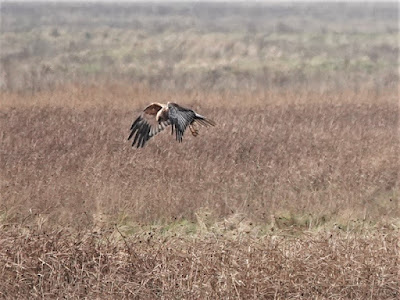A quick visit to RSPB Burton Mere to hear about the latest sighting produced a few worthwhile images. One of the area's winter specialities is flocks of Pink-footed Geese. Smaller than Canada Geese with dark heads and necks, a small dark bill and pale forewing. They have very distinctive calls.
Here in front of the Lapwings are a group of four Dunlin, one showing some dark on the belly that they acquire in the breeding season. The other waders are Redshanks. We will see both Dunlin and Redshank later.
On the left here is the only Black-tailed Godwit of the trip – these are never seen at the mouth of the Estuary where the similar Bar-tailed Godwit is more common. The two-tone, long and straight bill identifies it.
No mistaking a regal Curlew.
A head-on view of a Curlew.
Distantly over the marsh a few Marsh Harriers were looking to pounce on mice or voles escaping from the deeper channels being inundated by the incoming tide. I could not make out what this individual was trailing from one of its legs.
A different adult Marsh Harrier. Note the small feather in the middle of the wing leading edge. This is called the alula. It helps birds to manoeuvre at very low speed. Aircraft have leading-edge slats on their wings for similar reasons.
The upper wing pattern is seen rather better in a head-down view as it scans for play.
The head is visible here.
Spectacular. Mainly Dunlin apparently.
What my doctor calls my 'benign essential tremor' does not make this short video easy to watch. I was also a bit excited with the spectacle.
This swirling mass probably comprises Knots.
Another short clip. Note the gulls in the foreground: mainly Common Gulls.
A group of Oystercatchers disperse over feeding Dunlin.
A single Oystercatcher flies out...
.. and back! Note the minimal clearance between the wing-tip and the water. Note also how the white wing bar actually fades away rather than stopping short of the tip. White on the chin of this bird indicates it is a first winter bird.
Behind these Oystercatchers are Grey Plover which are rather stocky waders. Their back feathers are pale-edged giving them a mottled appearance.
All the 21 Ringed Plovers were gathered together. Here are seven of them.
A small group of Dunlin disperse. Some individuals show slightly droop-tipped bills. All show a dark line down centre of the white tail.
Two fly-by.
And now just one in flight...
..coming in to touch down...
...feet down.
In reflective mood.
Another flies in.
A view of the upper wing pattern of this species.
A size comparison between a Dunlin and a Redshank.
Another size comparison. Three Dunlin, two Redshank with a Knot – the medium-sized wader with the greenish legs.
A Knot comes in to touch down.
A Redshank flies by. This one with a rather muddy bill.
This view shows the white area in the wing and up the back with the barring on the tail.
Not all waders. Here a Little Egret with a dark bill and yellow feet.
An immature Herring Gull. Note the fresh inner primaries indicating this is a second winter bird moulting in to third summer plumage.





































